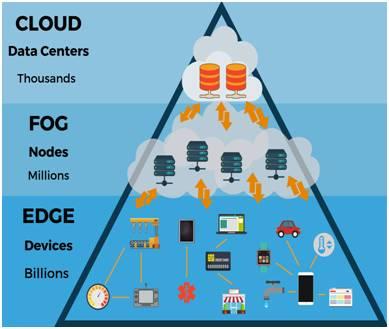Edge Computing vs. Cloud Computing vs. Fog Computing: Key Differences
Advertisement
This article compares edge computing, cloud computing, and fog computing, highlighting the key differences between these technologies.
Introduction:
Cloud computing has become a cornerstone for processing, analyzing, and storing data from client devices. However, with the rapid proliferation of IoT (Internet of Things) devices, the amount of data generated daily is exploding. Experts predict around 50 billion IoT devices will be online by 2020.
The traditional cloud computing model struggles to handle this massive influx of data due to its latency, volume, and bandwidth limitations. Fog computing and edge computing have emerged as solutions to address these challenges.

Image Courtesy: www.thinkebiz.net
- Cloud Computing: Storage is located far from the data source, leading to higher bandwidth usage and increased latency.
- Fog Computing: Acts as an intermediary between edge and cloud computing, minimizing bandwidth usage and reducing latency for improved performance.
- Edge Computing: Moves computation closer to the data source. Bandwidth is cheaper, and latency is less of an issue. Ideal for applications requiring autonomy, such as self-driving cars and Industry 4.0.
What is Edge Computing?
Edge computing optimizes the cloud by bringing computation closer to the data source – where the data is being generated. It involves delivering computing capabilities to the network edge to enhance performance, reduce operational costs, and improve the reliability of applications and services.
Edge computing utilizes “Edge Nodes” for data processing.

Image Courtesy: IEEE
Edge computing finds applications in various fields, including:
- Surveillance
- IoT (Internet of Things)
- Autonomous vehicles
- Industry 4.0
- Healthcare
- Financial services
What is Cloud Computing?

- Cloud computing provides convenient, on-demand network access to a shared pool of configurable resources (e.g., servers, network infrastructure, storage, applications).
- It encompasses essential features, service models, and deployment models.
- Cloud services are accessible from anywhere, at any time.
- In cloud computing, a fog layer is absent. End devices communicate directly with cloud servers and storage.
- Cloud deployment models represent specific types of cloud environments, distinguished by ownership, size, and access. These include:
- Public cloud
- Private cloud
- Hybrid cloud
- Community cloud
- Multi-cloud
- Distributed cloud
Cloud computing service models include IaaS (Infrastructure as a Service), PaaS (Platform as a Service), and SaaS (Software as a Service).
- A public cloud is publicly accessible and owned by a third-party provider (e.g., AWS, Microsoft Azure, Google Compute Engine).
- A private cloud is owned by a single organization, enabling centralized access to IT resources.
What is Fog Computing?

Fog computing extends the cloud closer to the devices generating data. These devices are called “fog nodes.” A fog node possesses network connectivity, storage, and computing capabilities. Examples include switches, controllers, routers, servers, and cameras. Fog computing is sometimes used interchangeably with edge computing.
Fog computing is primarily used for:
- Analyzing time-sensitive data at the network edge, minimizing the need to send vast amounts of data to the cloud. It can process IoT data in milliseconds.
- Sending selected data to the cloud for further analysis and long-term storage.
- Providing services to a large number of devices spread across a wide geographical area.
- Supporting devices operating in extreme conditions.
Difference Between Edge, Cloud, and Fog Computing
The following table summarizes the key differences:
| Requirements | Edge Computing | Fog Computing | Cloud Computing |
|---|---|---|---|
| Latency | Low | Medium | High |
| Jitter | Very low | Low | High |
| Distance between client and server | No hops | One hop | Multiple hops |
| Security | Undefined | Can be defined | Can be defined |
| Data enroute attacks | Very low probability | Low probability | High probability |
| Target user | Mobile users | Little mobility users | General internet users |
| Scalability | Limited | Little to few | More scalable |
Advertisement
 RF
RF



